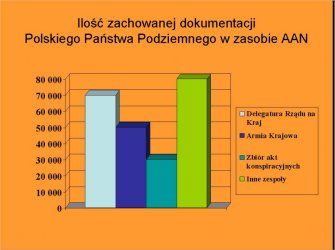
The amount of preserved PPP documentation in the AAN reserves)
in sequence: the Government Delegation for Poland; Home Army; the Collection of Conspiratorial Files; other groups
The documents of the Polish Underground State
The documents of the Polish Underground State, including those of the Government Delegation for Poland and Home Army, officially produced in the war, they are of the national provenance. They are produced by the same office like the Archive of New Files or the Ministry of Infrastructure, therefore they belong to the country. Lots of them were written by hand, sometimes on paper scraps or copying paper. All the same they don't defer in this regard from the documents of the Ministry of Culture for example.
In percentage terms, relatively not many documents of the Polish Underground State lived on. This that should be done is to take care of those that still exist. We tried to enumerate documents of PPP (= The Polish Underground State) that have continued to exist up to our times, taking into account the total number of the documents produced. We can state on the basis of a percentage analysis of the documents pagination, and so on a very precise data, that PPP during WWII came up with about ten million pages of documents. In all probability we can give credence to such a number.
At present we have in the collections of various Polish institutions over 500,000 pages; in the collections existence of which we are aware. The level of documents preservation in different regions of Poland may vary in a considerable way. The low preservation level of Home Army documents from the Eastern Borderland is almost shocking. This documentation is actually rather poor, and besides it is located in varied places. In the collections of more profound institutions there are some papers from the Lithuanian District (AAN [=The Archive of New Files], WBBH [The Military Office of Historical Research], Ossolineum). But taking into account the comparison of the Warsaw District we get the following proportion: one hundred documents of the Warsaw District and one document of the Lithuanian District. Such is the chasm in their quantity.
Considering the eastern districts, we don't have a verified knowledge of places where the documents are located. We have in AAN (= The Archive of New Files) among other things microfilms from the Observantine Archive (there are documents of the Vilnius District of Home Army Command, that were discovered in the nineties during the renovation of the Observantine Church in Vilnius), documents that stay in Vilnius. It is not a complete and a fully-professional knowledge nevertheless. Strictly speaking, we don't know what can be tracked down in Moscow, while there must be for sure many original documents of Home Army. From time to time, historians visiting various institutions and archives on the East say about Polish archive records seen there, but this knowledge is just about seeing one document in Minsk and the other one in Lvov. That knowledge isn't either organized or made available to historians, it is not a level of a serious technical data. For all the time we are obliged to scrutinize the PPP collection of documents not only from the angle of the lately most modern insurgent subjects, but most of all at the documents from other districts, from the whole structure of Home Army. For all the time we are required to speak loudly about values of this documentation, relying on good-will and nobleness of people who may still possess those documents and haven't granted them to the Archive of New Files yet. One should distinguish between the character of documents. The matter looks different if we deal with a sheet of paper sent, let's say from Vilnius during the Vilnius Operation. Then this is a private document. But if it had been written on an office sheet of paper of some unit and in the heading there would be a cryptonym of a given region, an inspectorate etc. then this is a national provenance. It doesn't matter how the majority of documents, often written by hand, was produced in the battle conditions. One should bear in mind that for many years it hadn't been even taken into consideration that PPP was a continuation of legal state authorities of the Republic of Poland. This led to the situation that still many people are unaware of it and treat the documents like a privately owned collection.
In the Archive of New Files there was established, some time ago, the V-th Department of Social Archives (that consists of the Archives of the Deed for Independence and of the Polish Community Abroad). From some time this group has been taking charge of collecting the documents, one among others, of the Polish Underground State. We have succeeded in collecting, in the last years, about 40,000 while the whole collection amounts to about 220,000 pages. This is the largest collection of PPP documents that has survived up to our times. Among the documents of the Archive of New Files about 70,000 is in the hands of the Government Delegation for Poland, 50,000 in the hands of Home Army, 20-30,000 it is the Collection of Conspiratorial Files while 80,000 is the property of other groups.

The amount of preserved PPP documentation in the AAN reserves)
in sequence: the Government Delegation for Poland; Home Army; the Collection of Conspiratorial Files; other groups
There is still a lot of work in the field of getting and securing the documents of the Underground Polish State. We have already analysed about 30% of whole documentation available in our Country. If we don't dedicate next ten years to looking intensively for the documents, also with the help of media, we won't get to many, many places where the documentation can be still found and that requires preservation. Besides there is still some danger that it can be destroyed.
Apart from the Archive of New Files the documents are preserved in many other places.
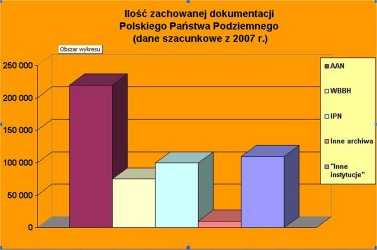
Institutions preserving the documents.
in sequence: AAN; WBBH; IPN; other archives; other institutions
According to an estimate from the year 2008 about 15,000 documents was amassed in the Military Office of Historical Research (= WBBH) and probably 100,000 in the Institute of National Remembrance (= IPN). In the other archives there is about 10,000 documents, while in other institutions approximately, over 100,000 documents in total. The Museum of the Warsaw Uprising possesses about 5,000-6,000 documents of the Polish Underground State in their original version at the most. This source is quite consequential.
Apart from these centres the documents are in other places including those where documents are kept and whose amount is ranging from 1,000 to individual copies. Sometimes these are places totally not related to the history of WWII like the Museum of Southern Podlasie or the Museum of the Kurpie Region Village or even the palace in Dukla.
In some instances AAN(= The Archive of New Files) collects documents in the form of copies that were obtained ,for example, from Skarzysko-Kamienna, from the Museum of White Eagle. Nevertheless, we are trying to get the original papers, as in the local museum the documents of Home Army from the sub-district Ilza and Jodla District are lying in the temperature of the surrounding environment, in winter conditions.
The situation of PPP documents collected in IPN, an exceptionally indispensable institution, is complicated. This is an enormous collection of archives concerning the most modern Polish history, as even just the very passport files are some kilometres long. Among those archives there are Home Army documents as well .By virtue of the fact that WWII documents are very often hidden the trial and judicial archives, a historian is just unable to go to the reading room and make use of the whole register of Home Army documents. Those limits concerning the documents in IPN are every now and then often related to the archival methodology, and also to the fact that PPP documents that are in the above-mentioned trial files eg. of Jan Kowalski, on account of the archival rules, have to stay in those files. They cannot be excluded and included in separate archival units called: Home Army. The issue is exclusively about a full and clear description of the records of those documents.
For the present moment, if somebody goes to IPN and will be looking for e.g. a set of documents of the Lodz Home Army District he'll get as well a piece of precise information about judicial files in which those documents can be found. Reaching them will be made easier for sure by a really significant collection of Home Army documents from the archive of the Ministry of Internal Affairs that was handed over to IPN some time ago. That collection from the Ministry of Internal Affairs has its own individual register that is already available.
Apart from those collections described above there are in Poland collections pivotal for describing the history of WW II, that in fact are not obtainable to historians in one hundred per cent. There are, one among others, the church collections. In the period of communism there appeared, in this regard, a specified situation that made PPP documents hidden from the Polish People's Republic authorities. Churches and diocesan archives were secure places for them. First such collection, about which one has to say in an archival sense, is the one of the Bright Hill Monastery. There was accumulated, so as to hide it from the communism, a large collection of legacy, and papers describing the independence deeds. Those documents I had an opportunity to scan. There are lots of them, and this that they stay out of a scientific circulation and that their availability for Polish historians and archivists is restrained results in a highly adverse situation. When e.g. we are to describe some consequential event from the war-period, from Lomza voivodeship, but we aren't assured that there aren't any unheard of accounts in the church collections, then the description may appear to be deficient.
There are some exceptions to this rule nevertheless. Not long ago did the Archive of New Files take over from the registry of the Warsaw Archdiocese - to its reserves the documents of Stefan Czarnecki "Gozdawa" Battalion. This is a collection of about 4,000 papers and even bona fide ones from the WWII period. It was within the bounds of possibility by virtue of sympathy and creative power of the director of the Warsaw Archdiocese Registry who agreed that his archive wasn't the best place for keeping such documents. As might be expected it did materialize with a tremendous assistance of the whole environment and people befriended with Lucjan Fajer, that were in service to us, and who earlier had directed our search . The effect is such that the authentic documents from the Archdiocese are with us, just like the whole legacy of Lucjan Fajer, pseud. "Ognisty."
As a consequence of the importance and an actual interest of Home Army the great job is done by the Museum of the Warsaw Uprising. The value of documentation is constantly increasing and museums of such kinds are demonstrating greater care of this type of documentation.
The next place where a profuse collection of PPP documents was gathered is the History Institute of the Polish Academy of Sciences (= IH PAN). There can be said many captivating things about documents from IH PAN as in terms of size the collection describing the WW II events and PPP is the fifth or the fourth on the list of the most sizeable. Two years ago IH PAN collection was granted to the Archive of New Files. There are documents phenomenal to comment on the history of WW II, as the collection was amassed by the former functionaries of KG AK (= the Main Headquarters of Home Army) and by recognized researchers. First, by the Chief of the Historical Military Office of KG ZWZ-AK (= the Main Headquarters of the Association of Armed Fighting of Home Army) Stanislav Ploski, then by Jan Rzepecki, prof. Tomasz Strzembosz, while Kazimierz-Pluta Czachowski supervised it all for some time. Rzepecki was even for some times a worker of the Department of the WW II History of IH PAN, and so amassing those documents took place in the circle of this environment.
One among others there are capitulation papers of the Warsaw Uprising elucidating the course of capitulation negotiations from 27th September 1944 - Gen. Bor-Komorowski's report; Alfred Sas-Korczynski's account written on 4th October 1944. The documents of the Warsaw Uprising capitulation are not just one sheet of paper, but ninety pages published as a matter of fact in "The Most Modern History of Poland." It is a document illustrating further stages of paying visits to Germans and conversing with them.
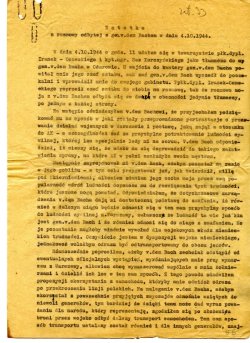
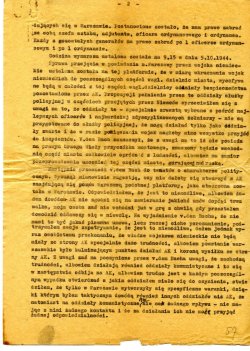
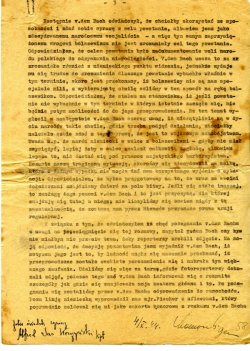
documents of the Uprising capitulation talks
The unveiled act of capitulation talks was in the possession of IH PAN. It is hard to say precisely how it got there, nevertheless, it was reported that it had been owned earlier by prof. Tadeusz Manteuffel. In the register of IH PAN there is no information about anyone that handed this document over. That knowledge was surely gained by Jan Rzepecki who had been in charge of that collection for some time. His handwriting is a matter of fact on the file in which capitulation documents were located. It is one of the three copies of the act. The second one is in the Military Office of Historical Research, as it had been earlier in the collection of WIH (= The Military Institute of History).
Next to the documents of capitulation in the collection of IH PAN there are papers granted by private citizens. Lots of genuine documents were handed over by prof. Bartoszewski in the sixties. There are also documents of "Zo¶ka" Battalion in the amount of approximately two hundred veritable ones. There is an archive of Albin Skroczynski pseud. "Łaszcz," particularly engaging that even partly was used by dr. Jan Gozdawa-Golebiowski in the monograph on the Warsaw District of Home Army. That collection of Albin Skroczynski was a fragment behind the registry and as if behind the awareness of people inquisitive about the Warsaw District. Still it was directed with the whole collection of IH PAN to our reserve and is available at the moment. Ladies and Gentlemen, I do encourage you to make use of it in our reading room.
I won't elaborate on other places, where the documentation of this type is preserved, it would take too much time, as there are some tens different centres. The Archive of New Files keeps the documentation of all places. We have already recognized 80-90% of their content paying special attention to maintaining the original, conspiratorial and insurgent papers from the WW II period. There is an urgent need to identify those documents. Let's hope that we'll manage to make arrangements for a conference on PPP documents for which we would invite the representatives of all museums, associations and other centres. A guide would be the final effect.
In the period of the Polish People's Republic, especially in the period just after the war, the experiences of PPP documents were decidedly specific. The majority of the uncovered documents of Home Army was at first used by UB (= the Polish Secret Service under Communism), then it took the route along various offices of administrative institutions of the state PRL (= The Polish People's Republic). About individual events connected with it Jacek Sawicki is writing in his book. More or less generally the route was the following: the moment when documents were seized by UB with the help of discovering the hiding places, denunciation, taking over the documents or arresting the owner of them, they went to UB offices. Some of them, if significant, went to the Ministry of Public Service (= MBP) and there they got into the judicial files. The separate collections were made as well, and they weren't included in the judicial files. After some time, when some of the documents were no longer constructive for the operation job, it went to the Central Archive of the Ministry of Internal Affairs (= MSW) and then to the archive of the Central Committee of PZPR (= the Polish Working Class Association) and then it got to AAN. The second part got to the Military Institute of History named after Wanda Wasilewska. In the very MSW there stayed the most intriguing documentation, because the least known, that in the second half of eighties was found in CA KC PZPR (= the Central Archive of the Central Committee of the Polish Working Class Association) and then in the Archive of New Files. It is gathered in the so-called collection of Conspiratorial Files.
Talking about documents from KC PZPR archive we are not certain whether the whole AK (= Home Army) documentation, the documentation of the Government Delegation for Poland etc. that was in KC PZPR got to us. We possess a sound evidence of this fact. In the seventies in KC PZPR there were done preliminary surveys that we keep in metal drawers. This is a well-done research on the files of the Government Delegation for Poland and Home Army. If we verify those cards with the present arrangement of thousand documents then we state there are some gaps. It is hard to say where they come from. Various party historians had an exceptional access to files. I remember, when I paid a visit to the magazine for the first time to see with my own eyes the Home Army collections I saw that at the end of it there was prof. Nazarewicz's file without a stamp, without a registry, put just like that. There were bona fide Home Army documents. It indirectly shows how easily available they were to some people. From the today's perspective we have knowledge of many situations when original documents, coming from different collections, cited by somebody in the footnotes were unthinkable to be found out later on.
The status of veterans' documents accrued by individual circles is noteworthy as well. When the first veteran office was liquidated there were many documents that veterans had brought when applying for a decoration or for a pension. There were lots of authentic documents like in the Main Board of ZBoWiD (= Society of Fighters for Freedom and Democracy), there were lots of valid documents from the Warsaw Uprising. There were orders of Home Army, of PAL (= the Polish People's Army) and A L(= the People's Army) and also the award-giving applications.
The subject concerning the documents of the veterans' office and ZBoWiD is immensely captivating, as it is connected with our quest. We have got the documents of ZBoWiD Main Board, though they just depict the administration duties of ZBoWiD. The Verification and Award-Giving Commission is unaccounted for, though it was in ZBoWiD. One part of the documentation is in "Radosław" files, and another part in the files of one of the soldiers from "Miotla" that held substitute functions in ZBoWiD Verification Commission. The majority of ZBoWiD documentation was lost during changing the location of the office from Dubois Street to Jerozolimskie Avenues, and regrettably we don't possess that documentation. Still we are looking for information that could clarify where it is. We are in possession of information from varied sources, that eg. somebody saw a lorry with files at Dubois Street that was harboured somewhere in Mazovia. But these details are unworkable to be verified by us, in fact we can do nothing with it. Though we are mindful of any particulars on it that would be priceless for us.
Once in a while the files of the World Association of Home Army Soldiers (= SZZAK) there are coming together with them files from particular environment of ZBoWiD. It was the case with "Zoska", Stefan Czarniecki "Gozdawa" Battalion. The documentation dates back to sixties, seventies. Talking about the Office of Veterans- it is an office of the central administration. On account of this and in accordance with law when the Office of Veterans desists from functioning like eg. the Committee of European Integration its files are handed over to the Archive of New Files, that, in the name of law, is even obliged to supervise the archive of the Office of Veterans. At some stages of history the collections of the Office will contribute to the treasury of the Archive of New Files. Some years ago, by the way, there was signed an agreement that concerned this issue. It should be taken into account by all veteran circles that are gathering the documentation. The eventual place for the documents from the Office of Veterans is the Archive of New Files.
AAN is a sterling site for the analysis of the WW II history, also from the German sources point of view. In the Archive of New Files there are, one among others, the Alexandria microfilms (the title was taken form the name of the place where they had been accumulated after the war - Alexandria, a city near Washington) that is a collection of microfilms of varying authorities, German military units from WWII period, with Gestapo files, Abwehra files, files of Oberkommando der Wehrmacht, differing central units eg. particular districts of General Gouvernement. If somebody can speak German fluently and knows Home Army documentation then he can easily examine the behaviour of the first side and of the second one. We have numerous documents of occupation authorities ranging from Gestapo documents to the copy of Bach-Zelewski's diary, that has been already brought out. We hold papers of German units that fought in Warsaw and on the Borderland. Sometimes it happened that historians from Germany had to visit Warsaw, as it was easier to make use of Alexandria microfilms there than in Germany. The originals and the copies that aroused their curiosity were still near Washington then. Other copies of those microfilms were possessed by WIH and by the Committee of the Nazi Crimes in Poland.
If you, Ladies and Gentlemen, do wish for learning something about those documents and about others that we have recently received I will invite you onto our website:www.aan.gov.pl where we are commenting on our assets, and of course briefly the most weighty collections that we have been lately given.
Now I would like to acquaint you with chosen collections that have been taken in the collection of the Archive of New Files over the last five years. It is related to the existence of the Archive of Independence Deed set up in the Archive of New Files for accruing that documentation, of course not only that from the Warsaw District and Warsaw region, but from other districts of the very Home Army Main Headquarters and commands of other conspiratorial organizations.
Looking at the presented instances one can realize how burdensome is the task set by the Archive of New Files as far as amassing the documentation of PPP is concerned. The look of those documents is acutely inconspicuous. As a rule they are copying papers with things written on them by hand. Alas it leads in many cases to destroying those documents. Frequently their accidental owners don't realize their historical significance.
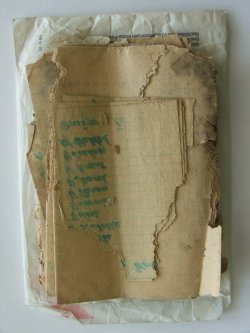
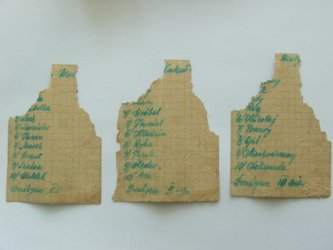
An illustration from the outpost in Tomaszow Mazowiecki
Documents from Tomaszow Mazowiecki outpost were dug out and brought to the Archive of New Files in the condition seen in the picture. Fortunately, we have the conservation department that secured the documentation and it has been already conserved. It is plain to see that it is the whole registry of the outpost in Tomaszow Mazowiecki district.
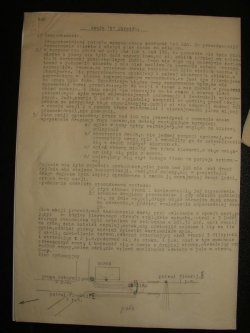
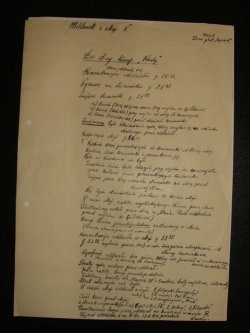
The documents of "Zoska" Battalion
Here, in turn, we have the documents of "Zoska" Battalion that also came to us from the PAN Institute of History (IH PAN). It is an exceedingly thought-provoking historical collection associated with the name of prof. Tomasz Strzembosz who made those documents to be located in the collection of IH PAN. They are coming form the so-called Giewont Box brought to light from a hiding place at Kwiatowa 10 Street.
Apart from the documents of the Uprising capitulation mentioned earlier we have in store other documents of Home Army Main Headquarters. They got preserved also due to the fact that an office process of producing those documents made that they were sent to varied district headquarters, various commands. Some years ago there appeared in the sphere of journalistic interests eg. the case of the order breaking up the Warsaw Uprising. Journalists presented it in such a way as if it had been the only order that had ever had being for starting the Uprising. Needless to say, the truth is that there were several dozen orders sent for introducing "W" hour to many cells on the same scrap of paper with the cryptonym of the street and the time. Similarly with the reports of Kedyw (Sabotage Executive Committee ) Warsaw District. The Chief of the Kedyw had to sent them to the commanding officer and so on and so forth.
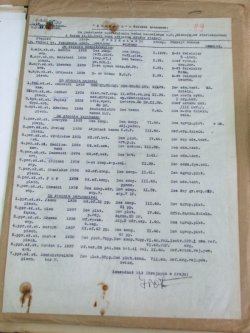
The order of nomination for "Grot"
A captivating narrative is connected with the presented document. This is "Grot"'s order of nomination found in the collection of Antoni Sanojca, pseud. "Kortum," that in turn was found by us in the files of Jerzy Nowak from "Chrobry II'" documentation of which, this time, was found by us left in the villa in Jozef, after the death of its owners. Members of "Chrobry II" circle were of service to taking it over. It was a great astonishment for us, that just Sanojca's documents were found in that place. One metre documentation delivered by the Commanding Officer of the First Unit of Home Army Main Headquarters Antony Sanojca. But for the pure chance and the imagination of "Chrobry II" soldiers they would have ended up on the waste heap. Please, try to see in the mind's eye how considerable risk there is all the time to the consequential documents. It should be constantly brought to the attention of those who own them.
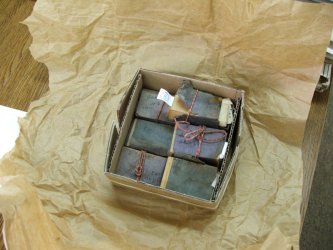
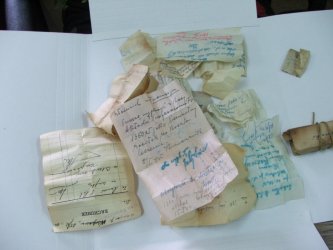
The document of the circle "Obroza" (= a collar; a ruff)
Below there is presented a find handed over to AAN by the circle of Home Army "Obroza," IV Region of the "Obroza" District. These are documents camouflaged during the war and after the war in the boxes of matches and handed over in the boxes as well. As luck would have it our department of conservation coped with it successfully. They are unpacked and made procurable to all interested.
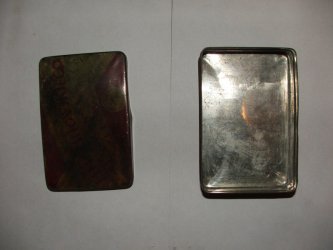
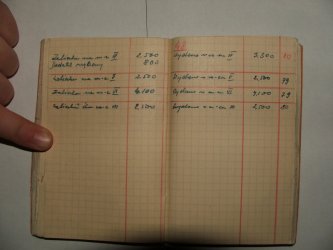
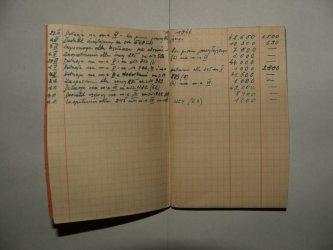
A metal box from IH PAN collection with the bills of KG AK (= the Main Headquarters of Home Army)
Below, there, in turn, is tendered a metal box from IH PAN where KG AK bills were locked up. It stayed in the store of IH PAN and practically it hasn't been protected up to now, as not all scientific institutions have departments of conservation. And that was why only when the documents had been transferred to our unit they were immediately made safe.
Other documents dedicated to eg. the Warsaw Uprising are numerous. Apart from the documentation of capitulation we take control, most of all, of Romuald Sreniawa-Szypiowski's archive.
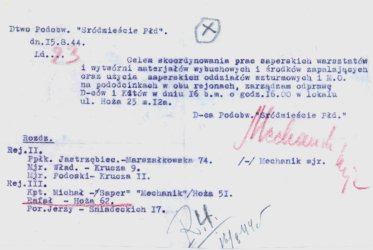
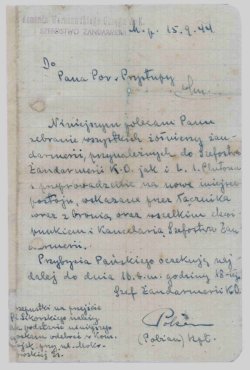
The documents from the archive of Romulad Sreniawa-Szypiowski
This is the most substantial exclusive collection dedicated to the Warsaw Uprising that consists, one among others, of 25,000 files of the Warsaw Uprising soldiers. These are files containing questionnaires, CV's, memoirs, souvenirs, photographs. As a matter of course there are files containing just an application for the Warsaw Insurgent Cross or just a filled in questionnaire that was sent out by Sreniawa-Szypiowski. We are trying to complete this collection. Conceivably this will bring an effect of extending it to over 30,000 individual files. Besides in Sreniawa's collection there are lots of authentic documents, about 500 in number and a really large collection, about 10 mln, of documents dedicated to the very Uprising, including accounts, memoirs, files of particular units, lists of insurgents, photographs from the Uprising, photographs of insurgent graves, photographs of soldiers and so on and so forth.
A very interesting collection is that handed over by Stanislaw Mazurkiewicz two years ago, dedicated to Jan Mazurkiewicz, pseud. "Radoslaw". In a practical way this is the whole archival legacy of "Radoslaw" that hasn't been available so far in the public collections as it was held by a son, who, like the greater majority of out benefactors handed the collection over for free.
Here one can see the documents from "Radoslaw" collection, those original from the war period. The most precious ones are those of KG AK at the end of December and at the beginning of January 1944/45 with the promotion applications and "NiedĽwiadek"'s orders of nomination. It is over our head to state precisely how "Radoslaw" came into the possession of them.
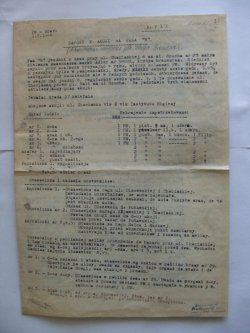
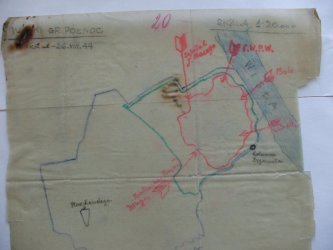
the documents of "Parasol" from Piotr Stachiewicz' s archive
One of the individual documents, that have lately arrived to our store are those gathered by Piotr Stachiewicz. Among them there are both the documents of "Parasol" Battalion and the Uprising documents. His collection landed in AAN while one of the documents went to the Jozef Rybicki's collection, that can be already found in BUW (= Library of the Warsaw University).
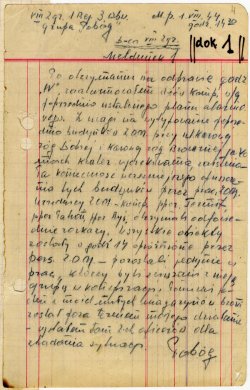
A document from the Fourth Company of "Krybar" Grouping
It is worth devoting a bit of attention to the documents of the 4th Company of the VIII-th Grouping of "Krybar." We have been looking for them for over a year. We have knowledge of them like we are conscious of the existence of several dozen other collections of documents. They got to the Archive of New Files due to the grandson of the company commander, Mr. Krzysztof Malinowski, who granted them for non-profit. The documents were publicly introduced during a ceremony at Warsaw University at the beginning of March 2008. Practically it is a complete archive of the 4th Company, almost 200 documents, well preserved. They cover almost all the combat trail of the 4th Company. They will explain many various and historical issues within the same group "Krybar," the functioning of "Bicz" (= a horsewhip; a whip) as a commanding officer of the VIII-th grouping etc. It goes without saying that some things referred to in those documents are acknowledged only from the reports to "Rog," or to the commanding officer of the First (I) District, though they are authentic documents, getting, relatively rarely, into the national collections. So immense a collection that has been given lately to the archive was "Ostoja"'s documentation, on the basis of which there was written a book by Marek Strok entitled "Iwo and Ostoja Battalions." There were several hundreds of original documents to which the archive attaches significance.
Apart from the collection of documents there were preserved in the archive of Malinovsky family- documents that almost portrayed the biographies not only of Marian Pobog-Malinowsky, the commanding officer of the Fourth Company, but also of his brother, that was in the rank of lieutenant in "Kilinski" Battalion. This is a family of immense patriotic traditions, taking independence actions from the time of the January Uprising to the 1905 Revolution, fights in WW II, legions etc. That insurgent aspect is as if a continuation of lives of this family members in the past.
Currently we are presenting a different document from those transferred to AAN in the last few months from Jerzy Hagmajer's collection, regarding the Confederation of Nation. We chanced on Jerzy Hagmajer's family that gave us the documents of the Confederation of Nation also non-profit. Those documents are already in the store of the Archive of New Files.
A set of documents, of great import, that was handed over to us 2-3 years ago. Being in the possession of prof. Aleksander Gieysztor, pseud. "Borodzicz" the Chief of Information Department of the Propaganda and Information Office of KG AK. These are documents pertaining to the whole aspect of AK actions. They are not directly connected with the function held by Gieysztor within Home Army Main Headquarters. He took possession of them at rather an unknown stage to us. We didn't succeed in finding out how prof. Gieysztor got hold of them.
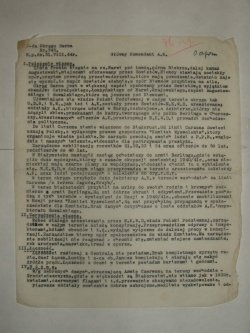
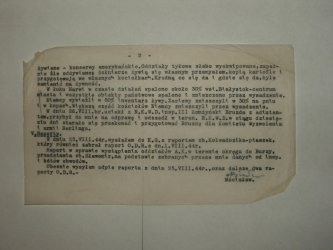
Documents from Aleksander Gieysztor's archive
Above one can view a photograph taken during the presentation of those documents. As it can be seen the documentation is stored in a cardboard box. On numerous occasions it is stored in such a way that is considered safe by the keeper. It should be said that keeping documents in the house, in a dry place isn't a safe way of preserving them.
A great archival adventure, it cannot be expressed in a different way, was the collection of the documents of Kedyw (Sabotage Executive Committee) from the Home Army Warsaw District from the period 1943-1944. We got those documents from Andrzej Krzysztof Kunert from the collections of the foundation run by him.
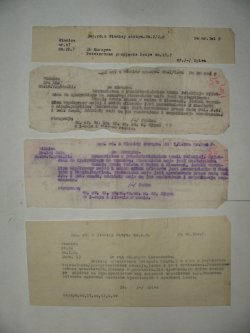
Documents from the collections of the foundation of Andrzej Krzysztof Kunert
This is a first collection of materials obtained from that so-called foundation. These are complete copies of typed reports of the Kedyw from the Warsaw District. It is just another version of originals from the times of WW II.
Not always does the situation look so optimistic like in the examples described above. Sometimes AAN tries to procure some documents for many years. It is just the case with the archive of "Dzik" (= a wild boar) Battalion from the Old Town about 400 original documents. Sad to say that we have information that those documents were devastated at the end of nineties, when we got the last confirmation that the archive existed.
The same can be said about the archive of "Gustaw" and "Harnas" Battalion which is a very collection of Tadeusz Macinski, pseud. "Prus." The lot of those original conspiratorial and insurgent documents is still undisclosed. In the quest we are supported all the time by "Gustaw-Harnas" circle. We'll be asking the media for help into the bargain. The archive, practically fundamental for describing lots of those units, is held by private citizens. Nevertheless, we don't possess a 100%confirmation that it was spoiled. Nobody saw it with their own eyes, though we have problems with getting in touch with the person who was the last to look at that documentation.
These two examples show that the documents were destroyed not only in forties and fifties, but even now they are. Even now for various reasons. Sometimes they demonstrate people's mindlessness and sometimes a total ignorance.
A great challenge for AAN is looking for the original documents using unconventional methods. One among others, they can be gained through seeking numerous hiding places from the war-period. It requires professional research nevertheless the Archive being an office doesn't have any tools to carry out archaeological research. We possess neither the administrative tools nor the technical possibilities. We aren't an archaeological institution to carry out such research. We know however that during the conspiracy and after the Uprising a large majority of documents was just kept in various hiding places.
We possess creditable, not very creditable and highly creditable information on places where the documentation was out of sight. A really full spectrum of it was hidden from Home Army Main Headquarters to the Bialystock District of Nowogrod sub-district etc. This information sometimes is included in the archival documents and sometimes transferred to us orally. Such a valuable collection taken out lately from a "bathroom" hiding place is the Archive of Warsaw District Command and the Command of the Western Sub-district of the Warsaw Region from the period VIII.1944 - I.1945 including about 4000 pages of documents. It is in the AAN store already.
Another example is the archive of "Lukasinski" Battalion hidden at Marszalkowska Street by, one among others, Franciszek Boh-Szurowski. We have Boh-Szurowski's letter from the half of fifties written from Kudowa to Lucjan Fajer, pseud. "Ognisty." In the letter Boh-Szurowski informs Fajer where he stored away those documents. It was in the cellars of the tenement at Marszalkowska Street where the Commander of "Lukasinski" Battalion stayed. Unfortunately, we have no information about those documents now. There is a suggestion, expressed in the above-mentioned letter, that they were taken out by the wife of the "Lukasinski" Battalion Commander, Olgierd Ostkiewiecz-Rudnicki, pseud. "Sienkiewicz," who on 13th VIII 1944 was killed in the Warsaw Uprising. Still there are no such documents in the Archive of New Files. If they had been seized and had been taken into possession by eg. UB they would have gone either to the Archive of New Files through the Archive of KC PZPR or they would have gone to the Military Office of Historical Research through WIH. They are not found in the officially approved collection of IPN. This way the fate of "Lukasinski" Battalion documents stays unknown. Maybe the archive was taken out by somebody, and either it is in private hands or in the IPN possession, that hasn't been published yet.
We have many such situations in the database and so there are about 150 another, similar post-war collections existence of which we are aware. These are different collections ranging from original documents of the Kedyw of Bialystock District, which we can, in a way, obtain from private collections, to the accounts from Home Army Silesian District.
As far as our capabilities are concerned we are looking for them through the media. We are publishing information in various places, on every occasion of our ceremony we hope we'll be gradually broadening this collection.
The example of success in this field is Jerzy Hagmajer's collection and Marian Pobog-Malinowski's documents. These are collections that we were searching for with the help of the media and we managed to track them down. Besides we managed to find many others using that means.
As it is plain to see there is a lot of work to do. We are describing the WW II history and being Polish historians, we have to account for those events though we haven't got yet onto the stage where all basic sources for the WWII history should have been already gathered. This reveals the influence of forty years of communism and an exceedingly negligent behaviour displayed then. There are some such examples of legacy in our country and abroad. They are invariably important for reporting on Home Army activity at the commanders' level.
Having spent half a year in Pilsudski Institute in New York I dedicated a lot of time to searching the archival legacy of Home Army Commanders that had settled there and met their end there, into the bargain. There is really a lot of work to do in that field. Owing to those quests the legacy of Stanislaw Blaszczak, pseud. "Rog" will turn up in Poland. This is a pivotal legacy, as there is an extensive correspondence between "Rog," and "Wachnowsky," "Zywiciel," and "Bor," "Radwan." Original documents from the period of war, for obvious reasons, aren't available there. The other part of "Rog" 's legacy in the form of souvenirs can be encountered in the Museum of the Polish Community Abroad in Orchard Lake.
Additionally, the legacy of Stefan Korbonski will present itself in Poland in the form of thirty eight cardboard boxes filled with documentation. One part of Korbonski's collections can be found in Hoover's Institute. Still that more noteworthy part will appear in Poland in the Archive of New Files due to the decision of Zofia Korbonski and due to Roman Rybicki's help. This legacy gives a rundown of aspects of action taken by Stefan and Zofia Korbonski.
Apart from that, the documentation of individual Home Army circles, that were organized there after WW II, will arrive from the United States to Poland. These are very unputdownable documents, especially for discussing the biographical entries of Home Army soldiers. It is worthwhile adding that the very Circle of New England Home Army had, in the fifties, eight hundred members.
The archival legacy of Home Army commanding level can be tracked down, in addition, in the School of the Underground State and in Sikorsky's Institute in London.Still, the amount isn't substantial enough to say that even the half of the legacy of the Commanders of KG AK we have managed to secure. In SPP (= the School of the Underground State) there are Bor's documents, in AAN there are documents of Sanojca, Mazurkiewicz, Karaszewicz-Tokarzewski, though this is a collection relating to his activity before the year 1939. In SPP there are materials of Ziemski, Pfeiffer and still there are relatively meagre collections reaching eg.50 archival units. There is also a collection of Taduesz Zenczykowski but eg. these are just clippings. Sometimes it is not only original documents that we are especially looking forward to, but just memoirs, accounts and post-war correspondence.
We have some documents of Stanislaw Solski, pseud. "Szczepankiewicz." One among others we have an account and even hugely compelling recording on the subjects of Gestapo agents. This is a highly dependable account as it was recorded by Boleslaw Jablonski with a post-doctoral degree who at the same time was Solski's son-in-law, and so that aspect of trust was decidedly crucial during giving the account. The very account itself had been published nowhere earlier. Professor Jablonski gave it to us four years ago.
In AAN repository there is a collection called: "personal deposits of PSZ (= Polish Military Forces on the West) soldiers, who were killed, died or committed suicides during the war". This is an exceedingly engaging collection together with the documentation from the level of Spychalski's brother and Sikorski's assistant to the level of a senior private from the First Armoured Division of Gen. Maczek. The second part of it has been already published by CAW (= Central Military Archive).
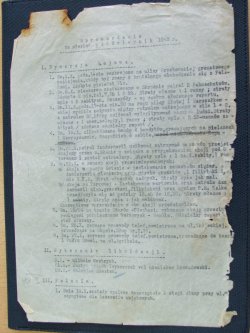
The first page of a monthly report of Kedyw from Warsaw District of Home Army
Unsatisfactory is the level of presentation of the documents of the National Unity Council. We have several dozen compulsive documents in the form of files. Those collections are coming from the archive of the Central Committee of the Polish Working Class Association (= KC PZPR).
Professor Strzembosz' legacy has been held by the Archive of New Files for some years. It was granted personally by prof. Strzembosz, and then after his demise it was done by his wife Maryla Strzembosz. It is quite a considerable collection, about 20 m of documentation of different kinds to which has been already given a detailed registry.
We are keeping a basic registry of those collections we have received during the last five years. Usually these are delivery-receiver lists on the basis of which we can judge about their substance.
At the end, I would like to thank you all who granted their collections to the Archive of New Files. It is worthwhile drawing attention to the role played by those who give things to national collections that have been kept by them, sometimes even for several dozen years, with putting their life at risk, especially in the fifties. I don't have to put into words that keeping those documents after the war was an enormous responsibility. It was connected with real perils. This that individual people, families of functionaries from AK stored those documents was exceptional audacity and all the deeper respect for Polish Country part.
The documents we received are really copious. The historians' inquisitiveness from the doctorate level to the professor level is unfortunately almost none. The majority of researchers make use only of the written sources and the existing publications. That is why our older friends speak with a sneer that historians are intimidated by archivists. The Archive of New Files has one characteristic feature that when it announces the appearance of new documents in store then one can make use of them the very next day.
AAN is the office of central documentation and the availability of materials is regulated by law and not by the clerk's whims. The crucial thing is whether the visitor can enforce them. There are of course internal rules that limit the availability. For instance, if the collection is being worked out, when the archivist is working on it, arranging it or examining it then practically that collection is unavailable. Just as it was in case of Herbert's collection that travelled to the National Library (= BN). BN made it clear-announced in the media that it would be available in two years' time at best, as this collection is being worked out . It is worthwhile emphasizing that one doesn't have to possess academic degrees to reach those documents.
The action of assembling the documentation of the Polish Underground State has to be still carried out intensively. A model accepted by AAN in the form of the existence of the Archive of Independence Deed has brought in the last few years real effects that exceeded the expectations both of veterans and us ourselves. At the moment in AAN there is the largest collection of conspiratorial and insurgent documents-both original- and also the documentation of veteran organizations embracing the soldiers of AK and of NSZ (= National Military Forces).
(This is an abstract of speech made on the meeting organized by the Association in the Uprising Museum.)
Mariusz Olczak
the Director of the Vth Department
The Archive of New Files
The Archive of Independence Deed in the Archive of New Files
The Archive of Independence Deed was set up in 1999 as the department of AAN. The Archive receives, in cooperation with the World Association of Home Army Soldiers, the Association of Warsaw Insurgents and the very soldiers of AK, documents of PPP. As a result of such action there were gathered the following collections:
Files of Tomasz Strzembosz; Files of the World Association of Home Army Soldiers, Warsaw District; the Association of Young, Political Prisoners 1944-1956 "Jaworzniacy;" Files of AK Jędrzejow District; Files of Jozef Rell; Files of the 9 Diversionary Company "Zniwiarz;" Files of Jan Gozdawa-Gołebiowsky; Files of POW-men (= Polish Military Organization); Files of Romuald Sreniawa-Szypiowski; Files of the 3 Vilnius Brigade "Szczerbiec" (from Zygmunt Klosinski); the Association of Soldiers of National Military Forces; Files of Zygmunt Malinski; Files of Franciszek Wojciechowski; Files of Kazimierz Leski; the Association of Veterans- the Cavalry and Horse Artillery Chaplaincy; the Association of Warsaw Insurgents; the Socialist Battle Organization; Files of National Battle Alert; Files of Sword and Plough Organization; Independent Battalion named after Maczynski, the Brigadier; the World Association of Home Army Soldiers - from the Warsaw District; the World Association of Home Army Soldiers Branch in the East Pennsylvania; a collection of conspiratorial newspapers; the Documents of West sub-district "Hajduki-Hallerowo" of the Warsaw District ZWZ-AK (= the Association of the Armed Fighting - Home Army); Files of Jakub Dymitrowski; Files of Roman Lewicki; Files of Wladyslaw Piotrovski; Files of Henryk Ratyna; Files of Marian Utnik; Files of Jozef Krzyczkowski; Files of Eligiusz Brulinski; Files of Home Army Battalion "Miotla;" Documents of Poland Independent Organization; Files of Antoni Sanojca; Files of Jerzy Nowak; Files of Eugeniusz Ajerski; Files of Edward Dietrich; Files of Stefan Tkaczuk; Files of Czesław Uhma - a collection of newspapers of National Military Forces; Files of Jan Mazurkiewicz "Radoslaw;'" Files of Hubert Borys; Files of Wladyslaw Roman; Files of Danuta Gałkowa; the Archive of "Gozdawa" Battalion (collected by Lucjan Fajer, pseud. "Ognisty"); Files of Jerzy Slaski; the Archive of "Zoska" Battalion; the Archive of "Miotla" Battalion; Files of Piotr Stachiewicz (concerning "Parasol" Battalion); Files of Colonel Stanislaw Nowicki; Files of Zbigniew Brym; Files of Halina and Bernard Zakrzewski; The Archive of the Scouting Association of the Republic of Poland; Files of Tadeusz and Jadwiga Kowalski; Files of the Circle of Radiotelegraph Battalion "Iskra" KG AK (= the Main Headquarters of Home Army); Files of Leslaw Bartelski; Files of Jerzy Niezgoda; Files of Tadeusz Cieslak; Files of Jerzy Slaski.
As part of the action we are accumulating the documents coming from other institutions and we are picking up information about places where the documents of the Polish Underground State can be found. Thanks to that we included in the store the archive of the Department of WW II History IH PAN functioning from 1957, the archive of Jozef Krzyczkowski pseud. "Szymon" from the Archive of the Centre for Deaf and Mute People in Laski and the Archive of Battalion named after Czarniecki "Gozdawa" from the Archive of Warsaw Archdiocese.
We are also saving accounts recorded by video techniques from AK soldiers and other conspiratorial organizations.
People who have engrossing documents showing the participation in fighting for Independence of Poland or those who would like to give an account about it are invited to contact us calling 822-90-53, by mail: mariusz.olczak@aan.gov.pl or personally in AAN building at Hankiewicza 1 Street.
Mariusz Olczak
The Director of the Independence Deed Archive
in the Archive of New Files
contact: ul. Hankiewicza 1
02-103 Warszawa
tel. 022 822-90-53
mariusz.olczak@aan.gov.pl
translation: Małgorzata Szyszkowska
Copyright © 2011 SPPW1944. All rights reserved.